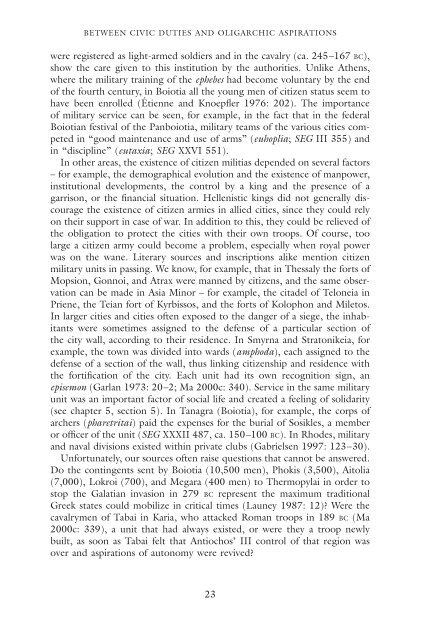WAR IN THE HELLENISTIC WORLD
WAR IN THE HELLENISTIC WORLD
WAR IN THE HELLENISTIC WORLD
Create successful ePaper yourself
Turn your PDF publications into a flip-book with our unique Google optimized e-Paper software.
BETWEEN CIVIC DUTIES AND OLIGARCHIC ASPIRATIONS<br />
were registered as light-armed soldiers and in the cavalry (ca. 245–167 BC),<br />
show the care given to this institution by the authorities. Unlike Athens,<br />
where the military training of the ephebes had become voluntary by the end<br />
of the fourth century, in Boiotia all the young men of citizen status seem to<br />
have been enrolled (Étienne and Knoepfler 1976: 202). The importance<br />
of military service can be seen, for example, in the fact that in the federal<br />
Boiotian festival of the Panboiotia, military teams of the various cities competed<br />
in “good maintenance and use of arms” (euhoplia; SEG III 355) and<br />
in “discipline” (eutaxia; SEG XXVI 551).<br />
In other areas, the existence of citizen militias depended on several factors<br />
– for example, the demographical evolution and the existence of manpower,<br />
institutional developments, the control by a king and the presence of a<br />
garrison, or the financial situation. Hellenistic kings did not generally discourage<br />
the existence of citizen armies in allied cities, since they could rely<br />
on their support in case of war. In addition to this, they could be relieved of<br />
the obligation to protect the cities with their own troops. Of course, too<br />
large a citizen army could become a problem, especially when royal power<br />
was on the wane. Literary sources and inscriptions alike mention citizen<br />
military units in passing. We know, for example, that in Thessaly the forts of<br />
Mopsion, Gonnoi, and Atrax were manned by citizens, and the same observation<br />
can be made in Asia Minor – for example, the citadel of Teloneia in<br />
Priene, the Teian fort of Kyrbissos, and the forts of Kolophon and Miletos.<br />
In larger cities and cities often exposed to the danger of a siege, the inhabitants<br />
were sometimes assigned to the defense of a particular section of<br />
the city wall, according to their residence. In Smyrna and Stratonikeia, for<br />
example, the town was divided into wards (amphoda), each assigned to the<br />
defense of a section of the wall, thus linking citizenship and residence with<br />
the fortification of the city. Each unit had its own recognition sign, an<br />
episemon (Garlan 1973: 20–2; Ma 2000c: 340). Service in the same military<br />
unit was an important factor of social life and created a feeling of solidarity<br />
(see chapter 5, section 5). In Tanagra (Boiotia), for example, the corps of<br />
archers (pharetritai) paid the expenses for the burial of Sosikles, a member<br />
or officer of the unit (SEG XXXII 487, ca. 150–100 BC). In Rhodes, military<br />
and naval divisions existed within private clubs (Gabrielsen 1997: 123–30).<br />
Unfortunately, our sources often raise questions that cannot be answered.<br />
Do the contingents sent by Boiotia (10,500 men), Phokis (3,500), Aitolia<br />
(7,000), Lokroi (700), and Megara (400 men) to Thermopylai in order to<br />
stop the Galatian invasion in 279 BC represent the maximum traditional<br />
Greek states could mobilize in critical times (Launey 1987: 12)? Were the<br />
cavalrymen of Tabai in Karia, who attacked Roman troops in 189 BC (Ma<br />
2000c: 339), a unit that had always existed, or were they a troop newly<br />
built, as soon as Tabai felt that Antiochos’ III control of that region was<br />
over and aspirations of autonomy were revived?<br />
23
















